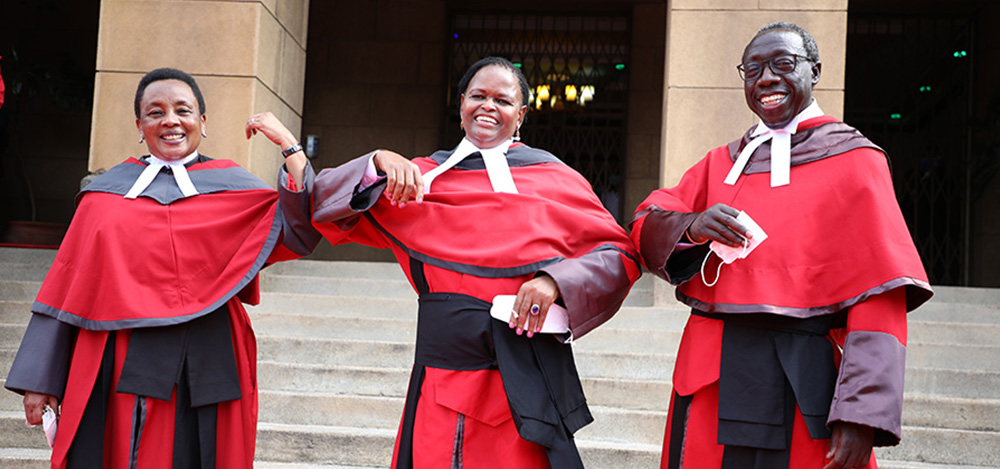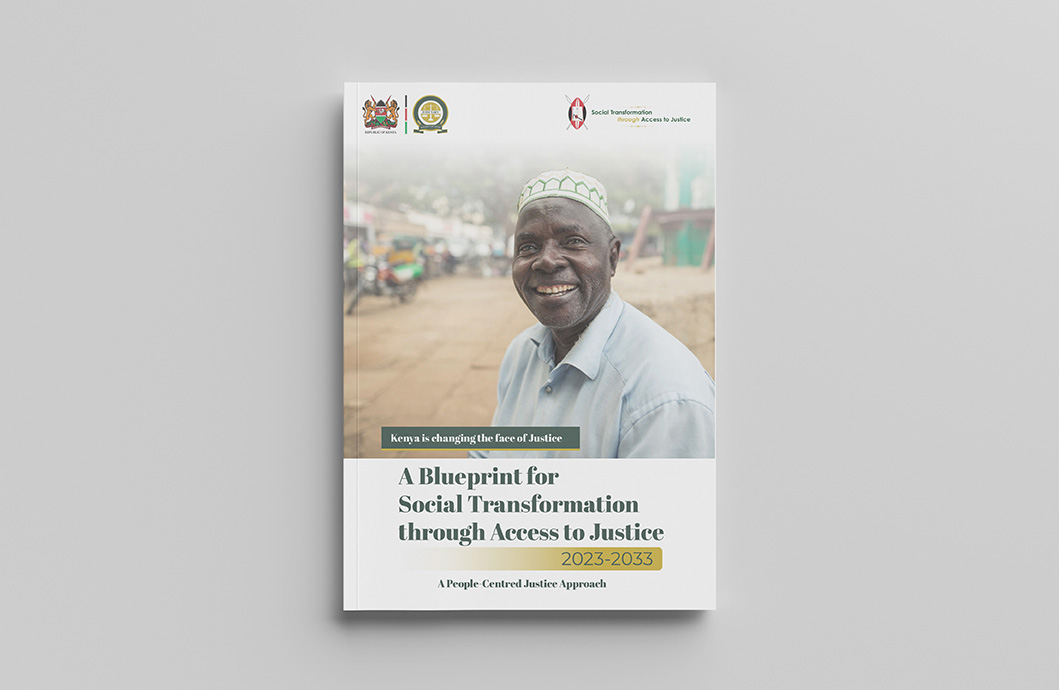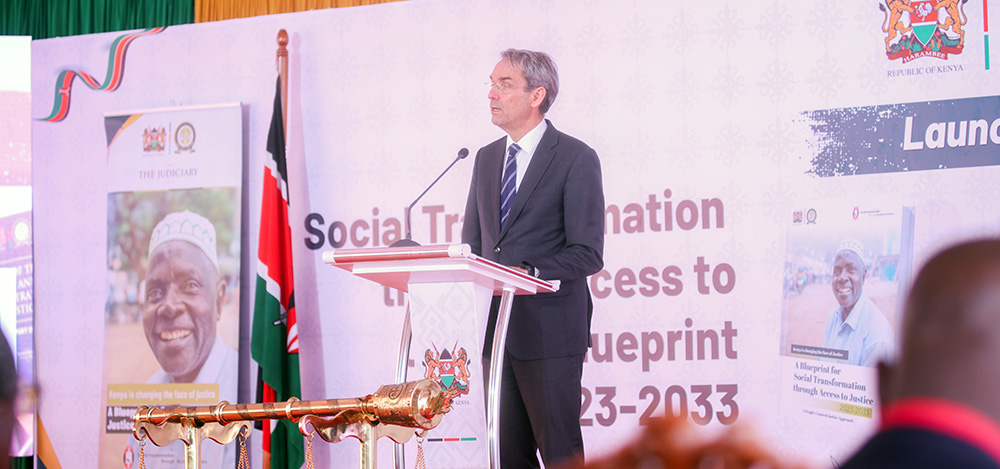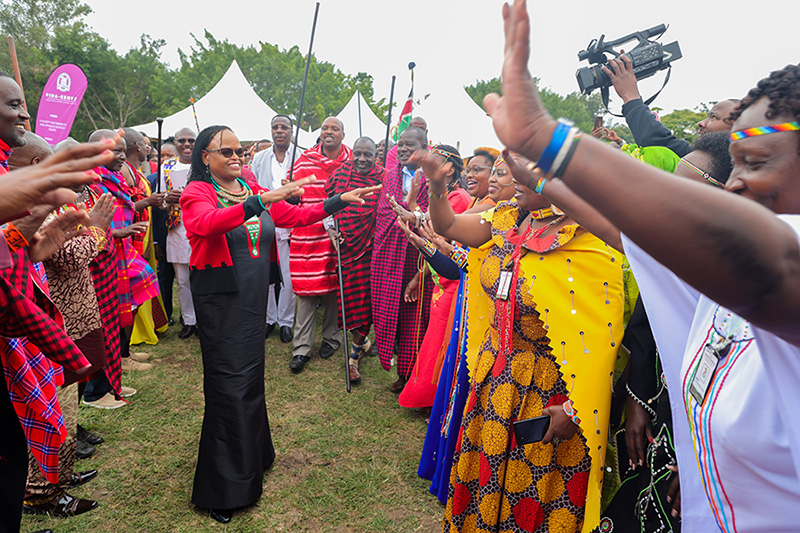By Sam Muller
Being ambitious about people-centred justice and closing the justice gap is not easy. I would like to share some reflections based on HiiL’s participation in the process of drafting the Social Transformation through Access to Justice (STAJ) Blueprint in Kenya, launched on 24 November 2023. They may be useful for others working on the same goal. Don’t take them as the Tablets of Moses; they may not apply to what is being done in other countries. But they may help us learn.

About STAJ
First, let me briefly set out what STAJ is. I think it is one of the most explicitly people-centred justice strategies I have seen of any Judiciary in the world today.
In September 2021, four months after she was appointed the third chief justice of Kenya under the progressive 2010 Constitution, Chief Justice Hon. Lady Justice Martha Koome shared her Social Transformation through Access to Justice Vision with the people of Kenya. At the launch, she let it be known that she would be developing the Vision into a 10-year strategy document.

At its core, the Blueprint is about utu-centred justice. In Swahili and Kenyan culture, this concept refers to humanity, kindness, and interconnectedness. It emphasises the importance of treating others with respect and compassion, promoting communal harmony and social well-being. What comes closest from Western culture is probably the notion of human dignity. The concept of utu demands that justice resolution and prevention are available for all Kenyans.
Based on that, the Blueprint seeks to open and widen doors of justice for everyone, with explicit reference to a promise made in the Kenyan Constitution. Based on the Justice Needs and Satisfaction Survey (JNS) HiiL helped conduct in 2017, we know that annually around 7 million Kenyans have a justice problem. Land disputes, family matters, debt issues, crimes, employment disputes, and more all affect livelihoods every day. As in most countries, less than half find a fair resolution. The Blueprint takes ownership of the full 7 million and not, as experienced in other judiciary strategies, only the cases that come to the courts.
A multi-door approach
To achieve this ownership, the Blueprint champions what is called a multi-door approach in which state and non-state justice providers are required to work together to deliver the justice outcomes needed. As the Blueprint beautifully words it:
“Justice, like water, needs to flow freely and uninhibited, permeating the cracks and crevices of societies and touching every life it encounters.”
The Blueprint provides foundations for a constantly learning justice sector that can adapt to change and challenges when needed. It does so in several ways including by further developing the already impressive data capacity of the Kenyan Judiciary; anchoring evidence-based working and the capacity for innovation throughout the process; setting clear parameters for collaboration across institutions in the realisation of the agreed outcomes; and recognizing that the work of measuring, learning and improving, will never be finished.
The Blueprint also indicates it will need Research and Development, innovation and anchoring people-centred justice capacities, like data collection, evidence-based working, innovating, and coordinating across agencies – both formal and informal.
To ensure that the design of the interventions and activities of the strategy are people-centred and to assess their impact and achievement, the Blueprint defines six ‘derivatives’:
- Agency and justice capabilities
- Human dignity (Utu)
- Generating reliable data
- Evidence-informed practices
- Curating innovative justice approaches
- Emboldened justice champions.
The Blueprint very explicitly reorients the role of the Judiciary “to that of a justice enabler, promoter, connector and provider. Activities and interventions must focus on building justice capabilities not just within the Judiciary, but across the spectrum of institutional and noninstitutional justice actors and within and outside the formal justice system, thus ensuring that all become champions for justice.”
This is quite a radical thing to put on paper: the Judiciary is not just a decision machine, but a “justice enabler, promoter, connector and provider”, across institutions and also outside the formal justice sector.

Focusing on outcomes
The Blueprint is focused on five outcomes that are, at first sight, more traditional and institution-focused. As the drafting process unfolded, we came to understand a little better why that is: to be ambitious in people-centred programming, justice leaders also need to be kind to the institution they belong to. For buy-in, you sometimes need to move ‘pole-pole’, as they say in Swahili. ‘Slowly-slowly.‘
Three of the five outcomes in particular stand out:
- Outcome 1: “A Strong Institution that is Independent, Accessible, Efficient and Protects the Rights of All, Especially the Vulnerable.”
It includes strategic objectives to “Expand the doors of justice”, to “Champion criminal, civil, and commercial justice reforms”, and to “Entrench people-centred justice data and evidence-informed justice services”.
- Outcome 2: “An Inspired Team of Judges, Judicial Officers, and Judiciary Staff Committed to Excellence in the Delivery of Justice.”
Two Strategic objectives under this outcome support people-centred justice programming: strengthening results-based management and fostering a culture of shared leadership.
- Outcome 4: “Deepened Partnerships that Enhance Coordination in the Administration of Justice”, includes a Strategic Objective to strengthen people-centred justice partnerships.
Under this heading, the plan sets a goal to “encourage collaboration in data collection and sharing by involving other justice stakeholders in standardising the collection, analysis, and storage of justice data; developing a statistical reference guide for the justice sector; identifying standard indicators for measuring justice outputs, outcomes, and impacts; and establishing a robust monitoring and evaluation framework for the justice sector to track.”
Now, let’s look at the learnings.
1. Take the long view
The STAJ Blueprint explicitly builds on the work of two predecessors, Hon. Chief Justice Willy Mutunga (2011-2016) and Hon. Chief Justice David Maraga (2016-2021). The first launched the Judiciary Transformation Framework (2012-2016), focusing on basic infrastructure. Hon. Chief Justice Maraga furthered that by developing the foundations of the Sustaining Judiciary Transformation Framework (2017-2021). With this foundation, the idea of serving 7 million Kenyans a year can be envisaged with some realism.
So, a lesson may be: ministries of justice and Judiciaries of the world, take the long view, building on each other’s work.
2. Legal documents matter
It helps a lot that Kenya’s Constitution provides solid foundations for the Blueprint. Article 48 states that every person has the right to have any dispute resolved by a court or, if appropriate, an alternative dispute resolution mechanism. The Constitution emphasises the importance of justice being administered promptly and without undue delays. Additionally, Article 159 emphasises principles of justice, including alternative forms of dispute resolution, to enhance access to justice for all Kenyan citizens. These articles are explicitly invoked in the Blueprints of Kenya. That carries a lot of weight.
So, a lesson may be: look for solid (national) legal foundations to invoke as part of the process of building momentum and support for a people-centred strategy: the Constitution, international treaties that have been enacted into law, case law, or whatever.
3. Start at home
As mentioned earlier, the Blueprint is founded on the concept of Utu. The justification for the strategy is not something required by SDG16, some international convention or declaration, or a report from an international Task Force on Justice. Utu is Kenyan. It resonates. It gives pride. It connects.
So, a lesson may be: national cultural concepts are of great value as part of the process of building momentum, support and understanding for a people-centred justice strategy.
4. Political risk strategies
When the Supreme Court of Kenya ruled that the 2017 elections had to be redone, Hon. Chief Justice David Maraga faced years of opposition from the ruling party. Between the Executive and Parliament, the Judiciary was starved of budgets. Confirmation of judicial appointments was delayed. Judgements were not enforced. This is a reality in many countries if a Judiciary exercises the functions entrusted to it by the Constitution.
From the day she was appointed (and with luck that a new President had been elected), Chief Justice Hon. Lady Justice Koome worked hard to repair the relationship with the Executive and with Parliament. She invited key representatives from both to the launch of the STAJ Blueprint, prioritising space for them to contribute including the Governor of Nairobi. At one moment, while introducing the Blueprint, the Chief Justice asked Hon. Chief Justices (retired) Willy Mutunga and David Maraga to the stage, unannounced, and gave each a brief moment to address the invitees. With this, she signalled to the nation: we, the Judiciary, are not alone. I, the current Chief Justice, am not alone.
So, a lesson may be: Have your political risk strategies in order. Involve potential opposition and bring both friends and frenemies to the stage, in plain sight for all to see.
5. Institutional buy-in is key
The Blueprint’s five outcomes set out a clear, institutional framing. Some may disappoint ardent people-centred justice champions who hope to see all Judiciaries in the world adopt outcomes that are entirely people-centred. However, institutions are important and need strengthening too. Judiciaries and ministries of justice in most countries in the world are overburdened and underfunded (see also the next lesson).
Therefore, a chief justice or minister of justice must consider their own colleagues, securing buy-in to help establish a position to move forward.
So, the lesson: be smart in the formulation of strategic goals. If, in Kenya, the Outcomes had been too ‘people heavy’, the people-centred justice baby would have been washed away with the bath water.
6. No money, no motor
The most critical enabler for the implementation of the STAJ Blueprint is money. The Kenyan Judiciary elaborately accounts annually for its performance in the State of the Judiciary Report (SOJAR). The 2022-2023 edition shows that over the past 3 years, the funding gap (requirements versus allocations) has been more or less a constant 50%. The same report sets out that the Judiciary had 10,325 approved positions of which only 6,643 were filled as of 30 June 2023, which means a 36% under-establishment. A deeper look shows that much of that concerns key positions for access to justice (e.g. magistrates). Overall, the budget for the Judiciary is stuck at around 1% of the national budget. The 2010 Kenyan Constitution set up a Judiciary Fund to give the Judiciary more budgetary freedom to allocate funding, but that Fund only became operational in 2022 and is still not operating optimally.
Chapter 6 of the SOJAR Report is essential reading for those wishing the STAJ Blueprint to work; I only highlighted a few core elements here. As part of our advisory work, the HiiL team researched existing or past reform plans within the ecosystem of the Judiciary and found that many initiatives have in the past petered out due to lack of funding. The plans were great but there were no explicit funding allocations, so these had to be fought for afterwards.
We also learned that, when it comes to donor money, Kenya has the challenge that it is seen by many as not being ‘low income’ enough to warrant support for the rule of law and justice. We are openly discussing these challenges with donors, helping make the case to support the STAJ Blueprint.
« I now see that people-centred justice incentives are radically different. Incentives to get the organisation and its people to focus on outcomes are radically different. That is a huge change we need to make. Like rewriting DNA. I had no idea it was that big!”
In my remarks at the Blueprint launch, I called on all funders—the Government of Kenya, development banks, donors, philanthropic organisations, and even private businesses—to embrace the plan, not only for what it seeks to achieve for Kenyan society but because it is the better investment.
The Blueprint details clearly how the funding will be used and the data-driven approach it takes makes investing and managing funds more effective if compared to ‘business as usual’ now. Data will show over time whether particular interventions are working. If not, immediate decisions to adapt or stop can be taken based on learnings that are grounded in data, not on hunches and abstract concepts. The approach also provides a foundation to develop sustainable funding models for justice delivery. All this should give the government and other funders more confidence to invest.
HiiL has also consistently been clear to the Blueprint Team: you must organise sufficient national funding from Kenya itself. A core reality is that funding is essential—focusing on people-centred justice interventions as such is not enough.
So, the lesson is you need to understand the national budget, the Judiciary budget, and the dynamics around them. You also need to understand donors and other funders and to work hard on making good arguments for the funding that is needed. You need to be on this, constantly. No money, no motor.
7. Align your incentives
One moment particularly stood out for me during the drafting process. It illustrated the importance of understanding incentives. While reviewing the draft, we were struggling to get the STAJ team to understand the depth of the people-centred justice programming way of working. We talked about putting outcomes at the centre, focusing on data, evidence-based working, innovation, and creating a real culture change.
I was unsure if our messages were resonating. Then during a break, a member of the Kenya team came to me and asked me again about the depth of the change needed. I tried again and in a lightning moment, he interrupted me and said he felt it.
“For the past 10 years”, he said, “all the incentives we have put on the system were about caseload. Doing more cases. Making that process as efficient as possible. The organisational incentives are about that and the personal incentives of all judicial officers focus on that. I now see that people-centred justice incentives are radically different. Incentives to get the organisation and its people to focus on outcomes are radically different. That is a huge change we need to make. Like rewriting DNA. I had no idea it was that big!”
When the break was over, and based on an intervention by this team member, the table of contents and the core outline of the Blueprint improved.
The lesson for me: be aware of the incentives and the DNA of the organisation and people you are working with. Connect deeply to that. It is only from there that you can become aware of the depth of the change that the people-centred justice approach requires organisations and people to make. This awareness helps you stay realistic, thoughtful, and targeted about the interventions you propose.
8. Talk to the nation
The launch of the Blueprint was accompanied by the presentation of the SOJAR report 2022-2023. In this way, the Judiciary meticulously accounted for its work over the past year and presented an ambitious 10-year plan. Smart move. And equally important, it was presented in full force on stage, on TV, online, and broadcast on the radio for the whole nation to absorb.
So, the lesson is that communication and advocacy are critical: Consulting broadly, messaging widely, marking the moment, and giving the strategy a real public push.

Take it in steps
The implementation of the 10-year STAJ Blueprint has been chopped into 3×3 periods. That is deliberate. The team did not put all its ambitions fully on the table. It went as far as it felt it could push the envelope now, and given the political environment (both within the Judiciary and outside, with actors like the Law Society of Kenya, the Bar Association, Parliament, etc).
The 3×3 year planning cycles will allow the Judiciary to constantly build, improve, and push further—all in line with the political economy that is gradually being developed. An example: the STAJ team knows that the regulatory environment for the legal services sector needs to change to achieve the goal of 7 million. I mentioned that, quite explicitly in my speech. We agreed that they could publicly disagree with me if needed. But it does not get a very explicit place in the Blueprint yet. It is the intention that it will, in the 3 x 3 planning cycle.
So, the lesson may be: know the opposition, gradually overcome that opposition and don’t move too fast too quickly. Pole-pole.
The blueprint of a Blueprint
Kenya is leading. But so are others. I was recently in Nigeria where three states have started implementing people-centred justice responses. And in Ethiopia, a national plan focusing on community justice is being rolled out using the same approach. The Kenya STAJ Blueprint is also a blueprint for others. Let us double down on this learning so justice providers in more countries get better at developing and implementing people-centred justice strategies.


